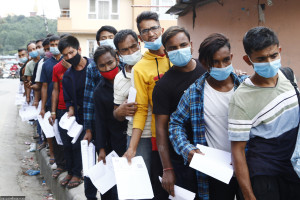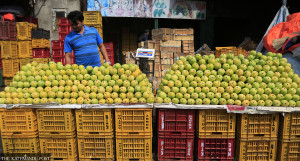Money
Vegetable prices go through the roof in Kathmandu
Vegetable prices in Kathmandu Valley have gone through the roof within the span of a month. This increase in prices, which has hit the average consumer’s pocket the hardest, is a result of a reduction in direct sales from producers to consumers due to growing involvement of middlemen in the trade.
Krishana Prasain
Vegetable prices in Kathmandu Valley have gone through the roof within the span of a month. This increase in prices, which has hit the average consumer’s pocket the hardest, is a result of a reduction in direct sales from producers to consumers due to the growing involvement of middlemen in the trade.
As middlemen enjoy high-profit margins, the increased price burden is passed on to consumers, traders said.
A quick glance at the retail price list of vegetables at Kalimati Market shows that rates of seasonal vegetables like potato, bitter gourd, brinjal, lady finger, carrot, and tomato have increased by 20 to 30 percent within a month.
Likewise, the price of off-season vegetables such as cabbage, cauliflower and green pea have jumped by 40 to 50 percent. Consumers blame this abnormal increase in the prices of vegetables to the lack of market inspection by the government. “Green vegetables have become very expensive. With Rs500, we can purchase only three varieties of vegetables,” said Jayanti BK, a resident of Kalanki. “I bought bitter gourd at Rs40 per kg a week ago. Today (Friday), it has increased to Rs65 per kg,” she added.
The price of mushrooms have also soared. A week ago, a kg of mushroom used to cost Rs400, now it has increased to Rs500, she added. Ladyfinger, which used to cost Rs65 per kg a month ago, now costs Rs85 per kg, which is a 30 percent increase. The price of string beans has also become dearer; it costs Rs115 per kg, which means a 65 percent increment within a month.
Narayan Subedi, a resident of Thankot, a regular buyer of vegetables at the Kalimati Vegetables and Fruits Market, the country’s largest vegetable marketplace, said that the hike in taxes by the government has increased the rates of all sorts of daily essential household commodities. “With the increase in price, low and middle-income people are in trouble, as it is getting difficult for us to manage finances by the day,” he said.
There are several other contributing factors to this rise in prices as well. The monsoon is a key factor, as most of the lands around the Valley are currently being used for paddy plantation.
However, many consumers have been placing the blame on the government, for it has not been conducting market inspections regularly.
Traders in the Kalimati market said that vegetables are available at reasonable rates in the farmers’ fields. But it becomes expensive by the time it is supplied to the market, as there are layers of middlemen involved in the business. The middlemen take home a hefty sum of money, in some cases more than the farmers’ earning, said traders.
For example, a vegetable that is originally priced at Rs15 per kg in the farmer’s field goes up by Rs22 per kg when it arrives in the customer’s hand. In some occasions, middlemen create an artificial shortage of vegetables and the prices of vegetables get inflated.




 22.09°C Kathmandu
22.09°C Kathmandu















